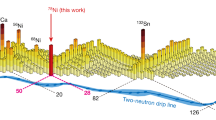Abstract
Research in nuclear triaxial deformation has revealed many exciting facts and figures over the last one and a half-decades. Although wobbling motion of nuclei was experimentally discovered at the beginning of the last decade, after almost 25 years of its prediction by Bohr and Mottelson, efforts are still being put to understand this rare nuclear phenomenon in greater detail. The concept of transverse wobbling is one such recent attempt which successfully explains the evolution of experimentally observed wobbling frequency with spin. The population of triaxial strongly deformed (TSD) bands in the A ∼160–170 region is favoured for which neutron number (N=92 or 94) is a topic of current debate. Experimental efforts are being put following Bengtsson’s calculations which indicate that the elevated yrast lines for N=92 isotones favour TSD population. In A ∼170 mass region, the ambiguity over the real character of certain strongly deformed bands has recently been removed by extensive experimental and theoretical efforts, and the bands have now been firmly established as either enhanced deformed (ED) or superdeformed (SD).





Similar content being viewed by others
References
S W Ødegård et al, Phys. Rev. Lett. 86, 5866 (2001)
D R Jensen et al, Phys. Rev. Lett. 89, 142503 (2002)
G Schönwa ßer et al, Phys. Lett. B 552, 9 (2003)
H Amro et al, Phys. Lett. B 553, 197 (2003)
D J Hartley et al, Phys. Rev. C 80, 041304(R) (2009)
P Bringel et al, Eur. Phys. J. A 24, 167 (2005)
D J Hartley et al, Phys. Rev. C 83, 064307 (2011)
R Bengtsson and H Ryde, Eur. Phys. J. A 22, 355 (2004)
I Y Lee, Nucl. Phys. A 520, 641 (1990)
J C Marsh et al, Phys. Rev. C 88, 041306(R) (2013)
A Neußer-Neffgen et al, Phys. Rev. C 73, 034309 (2006)
M K Djongolov et al, Phys. Lett. B 560, 24 (2003)
D T Scholes et al, Phys. Rev. C 70, 054314 (2004)
Y C Zhang et al, Phys. Rev. C 76, 064321 (2007)
J Wells and N Johnson, Oak Ridge National Laboratory, Report No. ORNL-6689, 1991 (unpublished)
S Mukhopadhyay et al, Phys. Rev. C 83, 044311 (2011)
E F Moore et al, Phys. Rev. C 55, 2150(R) (1997)
D J Hartley et al, Phys. Lett. B 608, 31 (2005)
I Hamamoto and G B Hagemann, Phys. Rev. C 67, 014319 (2003)
S Frauendorf and F Dönau, Phys. Rev. C 89, 014322 (2014)
J T Matta et al, to be published
Acknowledgements
The ANL operation staff at Gammasphere is gratefully acknowledged. This work was supported by the US Department of Energy, Office of Nuclear Physics, under grants DE-FG02-95ER40939 (MSU), DE-AC02-06CH11357 (ANL), DE-FG02-95ER40934 (UND) and the National Science Foundation under grants PHY-1203100 (USNA), PHY-1068192 (UND).
Author information
Authors and Affiliations
Corresponding author
Rights and permissions
About this article
Cite this article
MUKHOPADHYAY, S., MA, W.C. Nuclear triaxiality in the A ∼ 160–170 mass region: the story so far. Pramana - J Phys 83, 729–737 (2014). https://doi.org/10.1007/s12043-014-0864-9
Published:
Issue Date:
DOI: https://doi.org/10.1007/s12043-014-0864-9
Keywords
- Triaxiality
- wobbling excitation
- ULTIMATE CRANKER
- transverse /longitudinal wobbling
- enhanced deformed
- superdeformed




